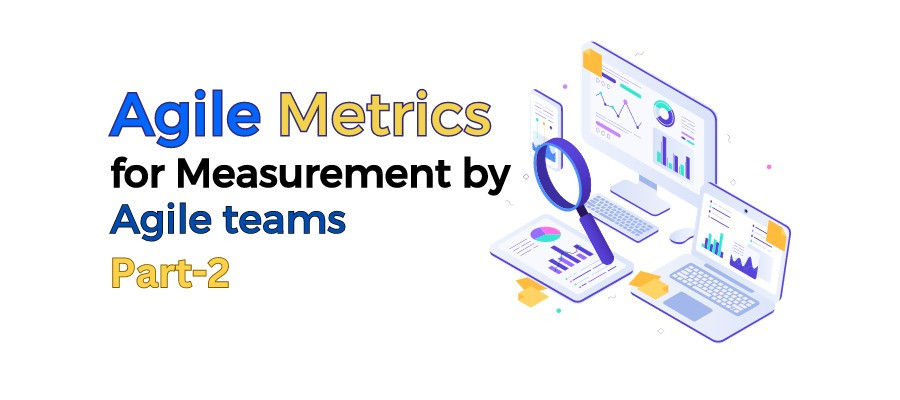Unleashing Agile Metrics Part 2 of 2: Maximizing Performance for Developers, Stakeholders and Management Teams

Following on from our last article (Part 1 of this blog) in which we discussed the essential metrics for Scrum Masters and Product Owners, we now move on to the next set of metrics that are vital for Developers. We'll look at metrics for measuring productivity, progress, and collaboration in Agile teams. Additionally, we will discuss the metrics that provide valuable insights about stakeholders and management teams, allowing them to measure the performance of Agile transformations and make informed decisions.
Developers Agile Metrics:
Velocity:
Definition: Velocity measures the amount of work completed by the Developers in a single Sprint. It serves as a historical performance metric and helps in Planning future Sprints.
Units of measurement: Velocity is typically measured in terms of story points. It represents the number of story points associated with user stories that meet the Definition of Done within a Sprint.
Sprint Burndown Charts:
Definition: A Sprint burndown chart is a visual tool that tracks the remaining work in a Sprint. It is regularly updated to provide insights into Sprint progress and aid in adjusting the remaining work accordingly.
Units of measurement: The X-axis of the burndown chart represents the Sprint number, while the Y-axis represents the remaining work in the Sprint, often measured in story points or hours.
Cumulative Flow Diagram:
Definition: A cumulative flow diagram is a tool used in queuing theory to visualize the quantity of work in different states. It provides information about arrivals, time in the queue, quantity in the queue, and departures, helping identify bottlenecks in the process.
Units of measurement: Cumulative flow diagrams are commonly available in project management tools such as Jira or Rally. They represent the status of tasks within a Sprint or release and reveal any imbalances or excessive tasks in specific workflow stages.
By monitoring velocity, Sprint burndown charts, and cumulative flow diagrams, Developers can gain insights into their productivity, make informed decisions, and collaborate effectively within the Agile framework. These metrics enable continuous improvement and help ensure successful project delivery.
Metrics for Stakeholders and Management Teams during Agile Transformation:
Agile Usefulness Index:
Definition: The Agile Usefulness Index measures the effectiveness and value of transitioning from traditional ways of working to Agile practices. It assesses how useful the Agile transformation has been in terms of time to market, customer satisfaction, company revenue, value delivered, and risk mitigation.
Units of measurement: The Agile Usefulness Index can be quantified through metrics such as time to market, customer satisfaction scores, company revenue growth, the quantifiable value delivered to stakeholders, and the level of risk averted.
Agile Awareness Index:
Definition: The Agile Awareness Index measures the level of awareness and understanding of Agile transformation, including its challenges, benefits, the Scrum framework, and other Agile practices among stakeholders.
Units of measurement: The Agile Awareness Index can be measured through factors such as the number of associates trained in Agile methodologies, the number of training sessions conducted, feedback received on the effectiveness of training, and the number of self-organizing teams that operate without a supervisor and consistently deliver high-quality products or features.
Management Sponsorship Index:
Definition: The Management Sponsorship Index gauges the extent to which the management team has embraced an Agile way of working and actively supports the Agile transformation.
Units of measurement: The Management Sponsorship Index can be assessed through metrics like the frequency of disruptions experienced by Scrum Teams, the metrics from the Agile Awareness Index, the level of resistance displayed by middle management towards change, and the availability of an Agile sponsor at each unit level.
These metrics provide invaluable insights into the overall impact and success of the Agile transformation, ensuring that stakeholders and management teams have a clear understanding of the value delivered, the level of awareness and adoption of Agile practices, and the extent of management support. By closely monitoring and leveraging these metrics, organizations can effectively track their progress, make data-driven decisions, and drive continuous improvement to maximize the benefits of Agile transformation.
As we unveiled a glimpse of the metrics for Scrum Masters, Product Owners, Developers, Stakeholders, and Management Teams in this 2-blog series blog, and if you're eager to explore the full range of metrics and unlock even deeper insights tailored to your specific needs, consider becoming a Premier Customer with our exclusive PremierAccelerate service
For more Metrics in addition to our Blog articles Part 1 & 2, you may request for exclusive access to ‘A Guide to 51 Agile Metrics’ written by Suresh Konduru – available to all our Value and Premier customers registered for PremierAccelerate program – a career transformation program exclusively by PremierAgile.
PremierAccelerate is our exclusive program that offers metrics to our Value and Premier Customers. If you're interested in accessing the full range of metrics and unlocking even more valuable insights, consider becoming a Premier Customer with PremierAgile. Contact our team to learn more about this premium offering and take your Agile journey to the next level.



